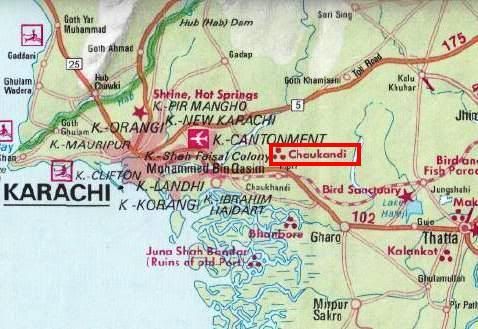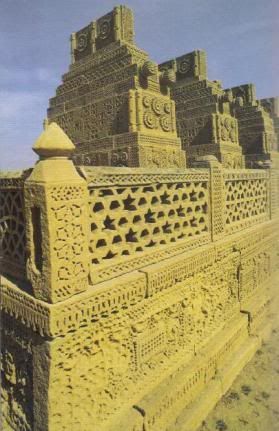This post is about the historic Chaukundi tombs located just outside Karachi. Before writing further I must admit that the last time I personally visited Chaukundi was in 1985 but I still vividly remember being fascinated by the stone carvings on these tombs. Following information comes from the tourist books and the Internet search. I’ve tried to include only the information which I could authenticate from multiple sources.

Since seeing is believing so lets start this post by watching the following video clip of Chaukundi tombs I found at the youtube.
If one travels out of Karachi on National Highway N5 – then between kilometer markers 26 and 27, towards the left side – lies an astonishing necropolis from several centuries ago called the Chaukundi Tombs.
Following map approximately shows the location of Chaukundi tombs on N5.

The word Chaukundi means ‘four-cornered’ and it got its name from the 5-star mausoleums of rich and influential people buried here and which are structurally supported by a column at each of its four sides. These columns usually support a dome or a canopy overhead the burial place. Hundreds of tombs stretch for nearly 3 kilometers. Another peculiar thing about these tombs is that they are all oriented in North-South direction.
Although a majority (of structures) consist of graves, there are some pavilion tombs supported by columns as well. Belonging to sixteenth century, the carving is similar to that found in the Samma Cluster at Makli necropolis. [source (3) below]
These tombs belong to Jokhio, Baloch and Burpat (or Burfat) tribes and most of them date back to between 13th and 17th centuries. The thing that makes these tombs stand out is the exquisitely-carved stone work. This stone work is unique to certain areas Sindh and Balochistan. Even though Chaukundi is the largest and most elaborately designed concentration of stone tombs in Pakistan, similar – but not so decorated tombs have been discovered all along the Makran coast and Lasbela in Balochistan and around River Indus delta in Sindh. In Sindh these sites include Malir, Dumlotee, Mirpur Sakro, Gujjo, Thariba, Sonda and Sehwan Sharif.
 The graves which belong to women have been decorated with stone carvings of flowers and jewelry which emphasizes the stature and wealth of the departed female. The graves of men have detailed stone carvings of horses, riders and weapons. Also included in the cluster of Chaukundi tombs are Muslim graves which tend to be unadorned.
The graves which belong to women have been decorated with stone carvings of flowers and jewelry which emphasizes the stature and wealth of the departed female. The graves of men have detailed stone carvings of horses, riders and weapons. Also included in the cluster of Chaukundi tombs are Muslim graves which tend to be unadorned.
The carving or motif which is most repeated on these tombs is a three-depth rosette which is most likely developed due to an early representation of the sun. Besides rosette, other carvings include the shapes of zigzags, flowers, crosses and diamonds.
There have been some reports of people stealing or defacing the stone carvings of these historic tombs. I’ve also heard recently that on weekend nights a local pir saayiN (Holy man) conducts services of removing ‘djinns’ from the psychologically disturbed people here. Hopefully both of these activities could be stopped from using Chaukundi tombs as their premises.
Chaukandi tombs is a protected site in the care of Department of Archaeology, Government of Pakistan.
References:
(1) Chaukhandi Tombs: Funerary Art in Sind and Balochistan, Oxford University Press 2003
(2) Insight Guide Pakistan – 2007
(3) Karachi -Illustrated City Guide by Yasmeen Lari – Oxford University Press 2000
(4) Spectrum Guide to Pakistan – 1998



















































@SHEZ
of course, I agree
MaiN Qurban UnahN Tau Bahoo
Qabar JenhaN di Jeway Ho
@Pakistani
True but the irony is that one visits their graves, whatsoever may be their architectural significance. The only exception is the Taj Mahal but that’s in India so out of the question. Even there, hardly anyone offers any respects to the buried. They simply enjoy their time and take pictures.
It is the shrines of Sufis that are still full of people after hundreds of years.
These carved graves cant be of poor people and are definitely of the tribal chiefs/ waderaas of that period, the poor haris/slaves were used to built these graves,,,,what a pitty, these waderaas only believed in getting graves of their ancestors decorated but never did anything for poors.
Just have a look on our history , you find tombs and Maqbraas of rulers/waderaas highlighted in books,,,,till today ,our rulers are doing the same.
Teeming millions of this continent always have remained and still are slaves of waderaas/jagrdaars and Badshaas/ploticians
@Owais
Thanks for the correction. Actually there is a criminology teacher at Karachi University Dr. Fateh Burfat who also writes for Urdu magazines occasionally. He uses f instead of p so I guess that might be the real pronunciation.
You are right about some words missing in local languages. P is missing in Hindi and Punjabi as well as they use “fir” in Hindi and “feer” in Punjabi. Same is the case for خ Khay where Hindi speakers can’t say Khoobsorat in the original pronunciation. Punjabis fare relatively better especially those living in cities but many still say “Khabsorat” especially those living in villages.
Urdu is unique in the sense that it has adopted every letter while still retaining its original vocabulary.
@Banjara. Makli is different. Makli is right outside Thatta and much much bigger than Chaukundi.
You are correct that there is a similar necropolis in Makli. There is a certain cluster of graves in Makli called “Samma cluster” which is similar as Chaukundi graves.
If you look at the road map provided in the post above, then right above Thatta you will see the half word ‘Mak’ in red font which is supposed to show Makli’s location. the word got cut when i cropped the image.
Makli will need a dedicated post by ATP just on itself :) Makli is claimed as the largest necropolis in the World. (source Yasmeen Lari’s book). Makli is also on UNESCO’s World Heritage List.
by the way I have not visited the Makli graveyard personally. I’ve only driven outside Makli and seen it from the highway. Above information comes from what I’ve recently read about it